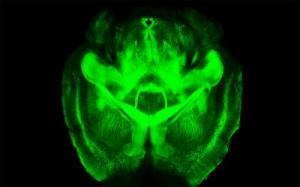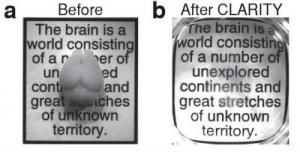On science blogs: Clarity?
THE THEORETICAL OBAMA SCIENCE BUDGET. It is conventional wisdom to say the President's budget proposals are an exercise in fiction-writing, DOA, and irrelevant. We'll see if that applies eventually to the Obama budget released this week. Meantime, here's a glance at the hypothetical budget items that affect science and medicine.
Wonkbook has a comprehensive roundup, everything you (or anyone else) would want to know about the proposed Obama budget. ScienceInsider's more specialized account chose to lead, and why not, with a double-digit increase for the National Science Foundation. The National Institute of Standards and Technology gets a big boost too, with emphasis on encouraging manufacturing innovation. The 1.5% increase for the National Institutes of Health is tiny, but would help blunt the 5% reduction from the recent sequester budget cuts.
Things look gloomy for the Environmental Protection Agency. Climate-change research is a bright spot: there would be cuts to climate-change research at NSF, but the rise at 13 other federal agencies would be 6% over 2012, a total of $2.65 billion. Homeland Security would double its science budget, with nearly all the increase going to build a new high-security facility in Kansas for research mostly on livestock diseases. Go here for details on these and many other science-related budget items and go here for commentary and analysis from the science community.
LiveScience's Tanya Lewis sees a glass half-full, quoting John Holdren, assistant to the president for Sci/Tech, thus: "The state of the R&D budget is quite strong." She outlines 5 such areas, including energy and brain research, STEM education, and cybersecurity. At ClimateProgress, Dan Weiss is thrilled about elimination of $39 billion in tax breaks for the oil industry.
Lots of commentary about funding for the National Aeronautics and Space Agency. At SciAm's Observations, John Matson focused on cuts, especially to NASA's education and outreach programs. There's far more interest in the NASA plan to capture an asteroid and move it close to Earth for a better look. Bad Astronomer Phil Plait likes the idea but is unhappy that money for it will have to come from other NASA projects like planetary science. That, he declares, is just crazy. Alan Boyle at Cosmic Log says NASA is already trying to identify candidate asteroids.
With Obamacare about to kick in, there's much to be said about materia medica. Kaiser Health News has collected a lot of it here and also here. At Shots, Julie Rovner argues that the President's proposed budget is anything but irrelevant for healthcare. He wants to raise the tobacco tax — guaranteed to pay off in improved health — and, for a double benefit, use the money to fund early childhood education. An appealing notion, but Wonkblog's Brad Plumer points out it's unsustainable because the education costs will go up up up and tobacco use will keep on declining. There's money for mental health services for the young though. The bad news includes higher premiums for the richer 1 in 4 Medicare beneficiaries and increases in copays. At HuffPo, Kolleen Bouchane is happy about a big boost for fighting AIDS, TB, and malaria.
DOWN WITH PROSTATE CANCER SCREENING. It's not news that screening tests for prostate cancer do more harm than good, statistically speaking. Yet many docs and patients still have enormous (if often unjustified) faith in the power of early detection, as Orac details at Respectful Insolence. So it is to be hoped that the just-published guidelines on prostate cancer screening from the American College of Physicians may have some impact on clinical practice. At News@JAMA, Bridget Kuehn reports the ACP recommends that
Men should be fully informed that they’re unlikely to benefit from prostate cancer screening and may face a substantial risk of various harms, such as complications from biopsy or treatment that may include infection, incontinence, or impotency …
The ACP guidelines paper gets praise from Aaron Carroll, the Incidental Economist, who says
It is evidence based, thoughtful, and still allows for patient preferences. Nonetheless, I expect the cries of “death panels” to start soon.
The word does seem to be getting out there, slowly. At HealthNewsReview, Gary Schwitzer, often a critic of first-person medical journalism, heaps unusual praise on a Men's Health piece by Jim Thornton detailing why he has decided against being screened.
DOWN WITH ROBOTIC SURGERY TOO? Two cutting-edge (no pun intended) prostate cancer treatments are also under fire. Schwitzer describes recent papers raising questions about proton beam therapy and robotic prostatectomy. At DoubleX Science, doc Jennifer Gunter takes out after robotic hysterectomies. Except possibly in cancer, she says, there's no justification for doing it with robots except to pocket the added $2000 cost. She quotes the American Congress of Obstetricians and Gynecologists as saying
there is no good data proving that robotic hysterectomy is even as good as — let alone better — than existing, and far less costly, minimally invasive alternatives.
Meantime, Lindsay Tanner reports at HuffPo that the US Food and Drug Administration is looking into the wildly popular, very expensive da Vinci surgical robot, suspected not only of causing death but also of engaging in weird behavior like hitting patients in the face.
Geez, that's surely a violation of Asimov's First Law of Robotics.
SHIRT TALES: SCIENCE JARGON. John Timmer has collected many, many examples of scientific jargon that is confusing not only to general public but also to scientists in different fields, where a word or acronym can mean something entirely different. One example: fission, fusion, nucleus, and plasma all mean different things in biology than they do in physics.
SHIRT TALES: HOW TO CLONE A PLANT. Jacqui Cheng's Ars Technica post on how to clone a plant would be at home on any gardening site. That's because it is, as she points out, a piece on growing tomatoes from cuttings. See, cloning isn't hard at all.
SHIRT TALES: GETTING A CLEAR VIEW OF THE BRAIN. The stunning photos in this post are the work of a new imaging technique called CLARITY (Clear Lipid-exchanged Anatomically Rigid Imaging/immunostaining-compatible Tissue hYdrogel). CLARITY can render organs — in this case a mouse brain, but it can be used on a deceased human brain too — transparent. Near-invisible. Ed Yong calls it "a phantom brain." He explains how and why, with videos, at Not Exactly Rocket Science. And so does Mo Costandi at Neurophilosphy.





